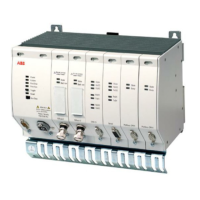6 Functional Description of the Ethernet Modules
6-2
If the battery is low and the voltage should fall under the value necessary for data re-
tention, the CPU board hardware signals this state, and the operating system reacts
accordingly.
The Ethernet module hardware is perfectly matched to the design of slots E1 and E2.
These slots are slightly different from slots F1 ... F4 (see Section 5.2, CPU board). For
example, direct DMA transfer to the CPU board main memory is possible. It allows
for rapid processing of the communicated data.
6.1 General features and handling
The Ethernet modules as a part of the overall AC 800F concept provide various fea-
tures which you may already know from the fieldbus modules.
6.1.1 General features
• One status indicator LED (State LED).
• One LED indicating insufficient battery voltage (Batt low or Battery LED).
• Automatic module identification: module-specific characteristics are read from
the module EEPROM while the module is starting up, and then processed. The
module will be linked to the AC 800F’s internal system bus only if it has been
identified properly.
• The AC 800F access to the Ethernet module via the internal address/data bus
allows for a maximum data throughput, with a data bus bandwidth of up to 100
MBytes/s.
• If the Ethernet module has an own processor with firmware memory, the firm-
ware can be updated via the AC 800F system bus.
• Every module can generate an interrupt which will be recognized and processed
by the system with different priorities.
• Data errors detected in the module memory will be reported through a parity er-
ror interrupt.
• An 8 MB address domain for memory access and an 8 MB address domain for
I/O access is dedicated to every module.
• Modules for 8-bit, 16-bit or 32-bit data buses can be connected. The memory
domain and the I/O domain of the module can have different data bus configura-
tions.
• The module will only work with proper electrical contact and a closed slide-lock.
This is ensured by two CardDetect signals applied to two connector pins at
maximum diagonal distance, and by a lock signal.
• Recognition and signaling of low buffer battery voltage

